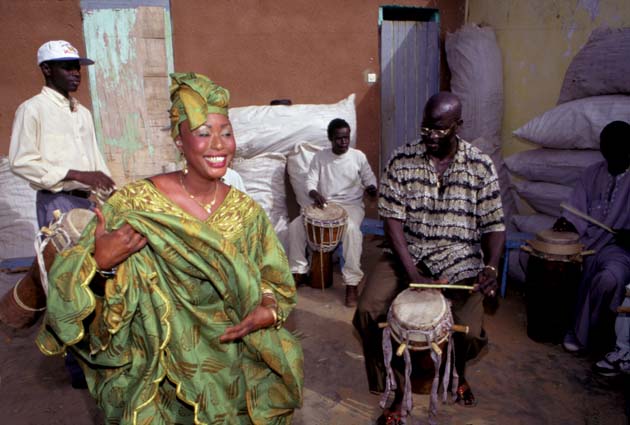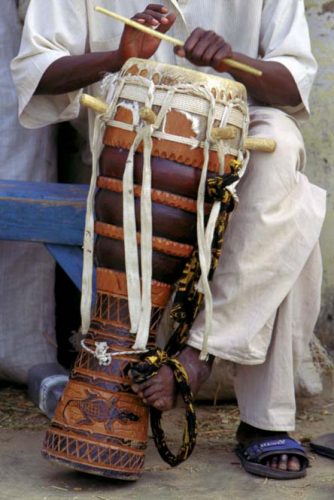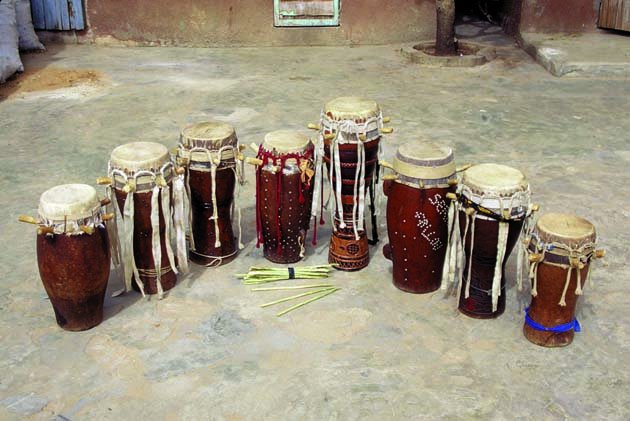
Walk for a day in any of the neighborhoods that surround Dakar, and chances are you will hear a crackling sound drifting toward you from one of the sandy, unpaved streets. At first it sounds like someone crushing a wicker basket. But the sound doesn’t stop, and you realize it’s symmetrical and shifting, as though someone were folding wicker in an endless series of kaleidoscopic shapes. Then you notice that the sound is floating on a chorus of bass voices, which seem to be conversing about something urgent.
You walk toward the sound, past young women braiding each other’s hair, past short-haired sheep tethered near doorways, past children drumming on tomato cans, and the sound grows stronger, block by block, until you turn a corner, and suddenly it fills the air and shakes your chest, and what was a brittle sound now rings with overtones.
You see a crowd of women blocking the street. They stand with their backs to you, wearing brilliantly colored gowns with elaborate embroidery. You walk closer and see that they surround a circle of painted metal chairs, where more women sit. Some giggle and point toward a young woman.
She is leaning forward slightly, with her hands on her knees, clutching the hem of her gown, which is pulled up over her back to expose her white cotton undergarments. You wonder what the women are pointing at, for the woman seems absolutely motionless. Then you see that her buttocks are swirling and leaping as though with a life of their own, and she is pursing her lips and wincing with the force of her concentration.
In the direct path of her gyrations, a group of young men are drumming with whip-like sticks and bare hands. Grinning and dripping sweat, two drummers in front watch her backside and accent her thrusts. Some of the drummers in back stare upward as though looking at something far away, their jaw muscles flexing with the pulse.
Before you have understood what you are seeing, the woman throws her pelvis sharply backward, then runs to a chair, laughing, while another woman springs to take her place. You have found sabar.
A Living Tradition
Carved out of reddish mango wood or mahogany, covered with goatskin, and circled with pegs, sabar are the traditional drums of the Wolof people of Senegal. The drums’ stone-age look brings to mind both the raw energy of Wolof drumming and its ancient roots.
Drumming and dance are a way of life for the Wolof. The term “sabar” refers not only to the drums but also to the music played on them, the dance that accompanies them and the gathering to dance. For the Wolof, drumming and dance still accompany most social gatherings, including weddings, naming ceremonies for children, official events and parties thrown just for fun. Because Senegal has a high birthrate, naming ceremonies occur especially often.
Sexuality infuses Wolof dance perhaps more than it does the dance of the surrounding cultures, such as the Fula, the Mandinka and the Jola. Some Mandinka call Wolof dancing “dirty.” But for the Wolof, sexual innuendo is cause for laughter.
Wolof dance celebrates sexuality explicitly, with a mixture of seriousness and comedy. While a woman dances with her buttocks, one of the drummers might playfully approach her from behind, until she realizes what is happening and runs away shrieking. Both men and women dancers usually end their dance with a suggestive gesture of their pelvis.
For one dance, women step to the chant “Oubil m’barke n’diaye, dékhine kai,” which roughly translates to “Open up your robe and show me your sweet dish.” On the last beat, the dancers briefly hike their robes, while the crowd squeals.
Drum Compositions
Wolof sabar drummers play two different styles of music. One style consists of dance rhythms. The other, called bak, consists of elaborate rhythmic compositions. Drummers typically play baks before the dancing begins.
New baks appear in Dakar as quickly as new popular songs appear on AM radio in the United States. Wolof kids trade baks like American kids trade baseball cards.
In a sabar drum troupe, each drummer plays a drum with one bare hand and a stick about 16″ long. The drums are tuned to answer each other by their size, shape and method of stringing.
Some of the drummers play accompanying rhythms, while others solo. The accompanying rhythms are carefully crafted so that when they are played together, they interlock to create simultaneous conversations. The bass tones from the hand strokes make one conversation, while the stick strokes make another.
The accompanying parts are called the talmbat, the touli and the m’balax (pronounced m-BAH-lakh, where lakh rhyhmes with lock, but the kh sounds like you’re clearing your throat). Each part provides a different rhythm for different dances. The most important of the accompanying parts is the m’balax, which a sabar drummer must first master before learning to play any other rhythm.
The m’balax has given its name to a Senegalese style of Afropop. The style emerged from the group étoile de Dakar, which included a young singer named Youssou N’Dour. M’balax Afropop typically incorporates one or more sabar drums playing an m’balax rhythm. However, m’balax Afropop rarely incorporates more traditional drumming than this, especially in the recordings exported from Senegal. Traditional sabar drumming continues to offer a universe of music not heard in current Afropop.

Anticipating The Backbeat
The most distinctive trait in Wolof drumming is the placement of the dominant bass beat, which always anticipates what rock and roll musicians call the backbeat. That is, if you count a rhythm as “1 – 2 – 3 – 4”, the Wolof place the strongest bass tones just before the 2 and the 4 (the backbeat). The amount of anticipation varies, depending on the particular rhythm being played. Each placement gives the music a subtly different flavor.
Another notable trait in Wolof sabar drumming is that the parts incorporate flams, or grace strokes (a drummer’s strokes landing together at almost, but not quite, the same time). When the drummers play together, their flams interlock to divide time into patterns much finer than a single drummer could play. The flams add a texture to the music that is feathery yet precise.
A Passion For Syncopation
Sabar rhythms can be especially syncopated. Some are so strongly syncopated that even Wolof dancers have a hard time dancing to them. The more difficult rhythms give the better dancers a chance to excel.
Despite the intensity of syncopation, all Wolof rhythms are four-beat dance rhythms. There are no odd-metered rhythms, like 5/4 or 7/4. However, Wolof drummers do not count their rhythms. Instead, they relate them against a basic reference rhythm, the way that Afro-Cuban drummers relate their own rhythms to the clave.
The Wolof “clave” aligns with the English phrase “a real tall tree.” That is, you can hear the Wolof clave by repeating “a real tall tree, a real tall tree …” The downbeat — emphasized by the dancers and by anyone clapping — always lands on the word “tree.”
Unlike Afro-Cuban drummers, who always play their clave as an essential part of the music, Wolof drummers do not usually play the Wolof clave explicitly. Instead, they use it as a mental reference. Typically, they play it only to start a bak in unison or to teach a rhythm to someone.
The Wolof approach to drumming is so intuitive and tuned to tradition that Wolof drummers do not have a name for their clave, just as Western musicians do not have a name for the even ticking of a metronome.

Ancient Technology
The m’beungbeung toungoné and m’beungbeung bal are accompanying drums that always play m’balax. Both are goblet-shaped and open at the bottom, but the toungoné is smaller and tuned higher. For many rhythms, the two m’beungbeungs play m’balax parts that differ from each other. The n’der is a solo drum. It’s shaped like an m’beungbeung, but taller, sometimes extending almost three feet. It can produce both a deep bass tone and a high, sharp stick tone. A second n’der sometimes plays an m’balax part. This part often differs from the m’balax played by the m’beungbeungs. The lambe is the primary bass drum. Its bottom is closed and its sides bulge gently, making the drum somewhat egg-shaped. The lambe plays the accompanying part called the touli. The gorong talmbat is the tenor accompanying drum. It’s shaped like the lambe, but it’s slightly smaller and tuned higher. It plays the accompanying part called the talmbat. The gorong yeguel, added to sabar in the 1950s by sabar drummer Doudou N’Diaye Rose, is now the principal solo drum. It’s shaped like the lambe, but it’s strung tighter and has a bright bark.
If a troupe is missing the lambe or gorong talmbat, the drummers might add a drum called the thiol (pronounced chol, to rhyme with coal). The thiol resembles the lambe and the gorong talmbat, but its size is between the two. A drummer can tune a thiol to serve as either a lambe or a gorong talmbat. Alternatively, a drummer can use the thiol to play a part called the touli-talmbat. As the name suggests, the touli-talmbat combines the parts played by the lambe and gorong talmbat.
A soloist usually plays the gorong yeguel or the n’der. However, any of the drummers can take a turn soloing and usually do so at some point in a performance. Wolof drummers call the solo part the xar (the x sounds like you’re clearing your throat).
A member of the traditional woodcarving caste, called the laubé, carves the drum shells. A drummer mounts the goatskin himself. First he soaks the skin to soften it, then he lashes it to the pegs, weaving cords through slashes in the skin. Last, he shaves the hair off the top.
Tabala Wolof
Wolof rhythms have heavily influenced another style of Senegalese drumming, called Tabala Wolof. Tabala Wolof is the ritual drum music of a Senegalese Sufi order called the Qadiriya. Qadiriya drummers play during nighttime worship to inspire ecstatic singing. Unlike sabar drumming, the lead drum is a massive wooden kettle drum. A drummer plays it with two long sticks, which are half as long and almost as thick as broom handles.
In some ways, Tabala Wolof parallels African-American gospel music. Both styles are sacred, and both were born from African rhythms about the same time – in the late 1700s. During worship, Qadiriya worshippers even sway to the same “gospel step” as American worshippers.
Sabar Serer
The Serer people, who live primarily south of Dakar, also play sabar drums. However, they use the drums to create their own music, with its own distinct flavor. Their music relies less on flams and more on fast, interlocking triplet rhythms. To some extent, Serer drum music resembles the drum music of the Mandinka and Jola, who live even further to the south. However, the Mandinka and Jola each play their own style of drums and have their own distinct style of drum music.
The Road Ahead
Sabar drumming has permeated many aspects of Wolof culture. Like other West African peoples, the Wolof have used drumming to heal the insane, cast spells, and communicate, using rhythmic patterns to represent spoken phrases. Traditionally, the Wolof even drum to put children to sleep.
As Senegalese embrace the culture of the “developed” world, the world seems to be embracing aspects of Wolof music and dance. In recent years, Stevie Wonder has hired a Senegalese dancer to consult on a music video, and a Wolof drum troupe has opened for the Rolling Stones. Youssou N’Dour has found international acclaim, and though most of his music is only tinged with m’balax, his success is still introducing the world to some of the flavor of sabar drumming. If current trends continue, sabar drumming and dance will have a growing influence on the world’s popular music and dance.
Adam Novick is a producer for Village Pulse, a record label that specializes in field recordings of traditional African percussion. This article is in part adapted from the notes to the Village Pulse recording Sabar Wolof: Dance Drumming of Senegal.
